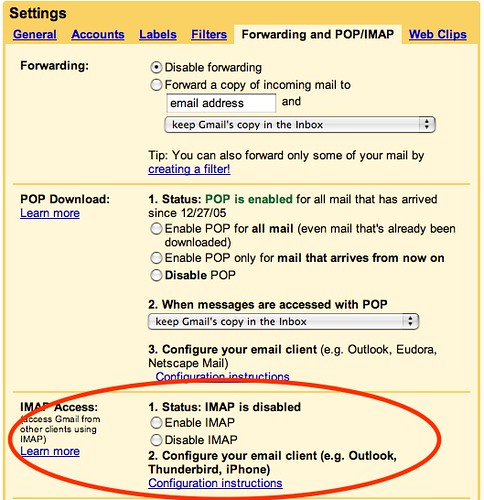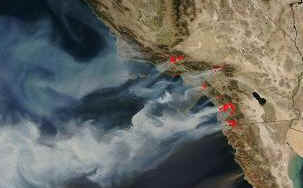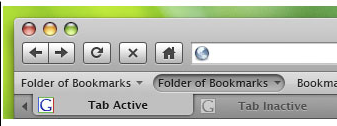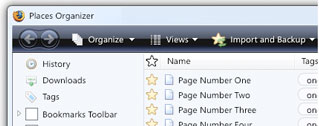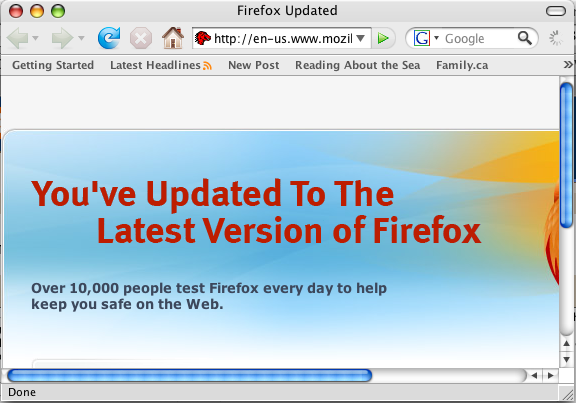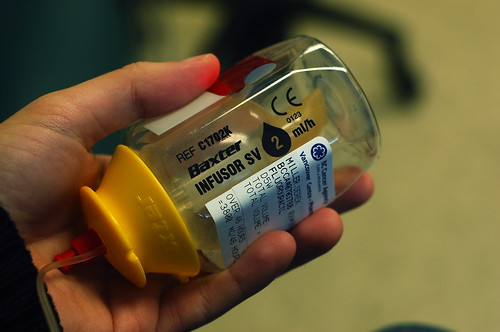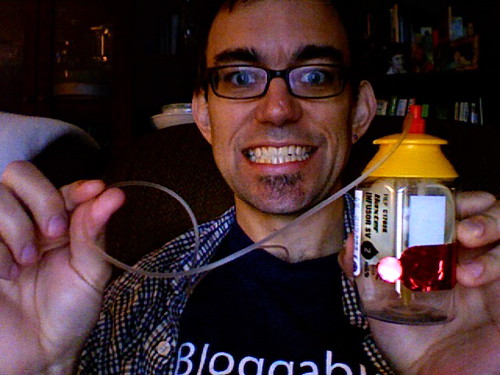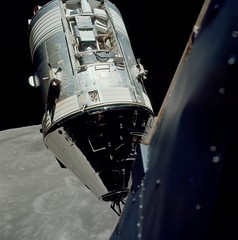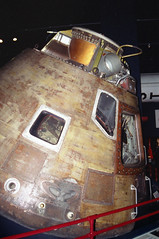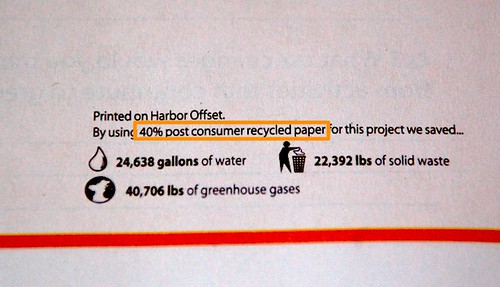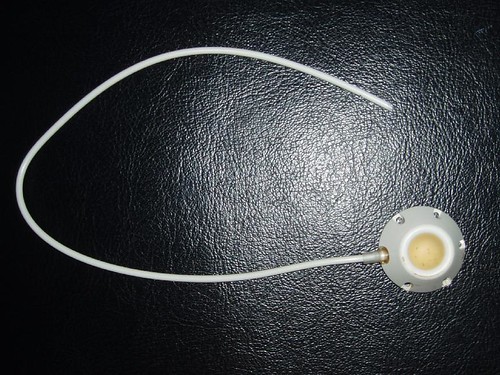Penmachine
31 October 2007
Happy blogiversary
Darn, I missed it again. Saturday, October 27 was this website's seventh birthday as a blog—it existed for three years and a bit before that as a set of plain old "web pages," but not with regular updates. I've been using Blogger to run it ever since that switch. (If I were starting today, I'd probably go with WordPress, but there's a lot of momentum.)
So happy blogiversary this week, Penmachine. I haven't tried a word count in a long time, but I'd bet it's scary. I'm up to 2,927 individual posts, so this blog is probably north of 800,000 words by now.
Labels: anniversary, birthday, geekery, web
Halloween simulcasting in the family
 My wife and I both co-host podcasts. Hers, Lip Gloss and Laptops, comes out more often, on a regular weekly schedule, while mine, Inside Home Recording, is more sporadic, usually every two weeks, although it's been a month since our last show.
My wife and I both co-host podcasts. Hers, Lip Gloss and Laptops, comes out more often, on a regular weekly schedule, while mine, Inside Home Recording, is more sporadic, usually every two weeks, although it's been a month since our last show.
There are lots of reasons for that, mostly that they are very different programs about completely different topics (cosmetics and music recording, respectively), with entirely different production styles and workflows. I also have my own individual podcast here at Penmachine, which consists mostly of instrumental recordings I've made and released to the public, as well as some interviews, spoken-word segments, and other stuff. Because of my cancer treatment, I haven't added anything to that show in months.
Today, by coincidence, is the first time all three shows have a new episode out within the same 24 hour period, and on Halloween to boot. Go give them a listen:
- Lip Gloss and Laptops Episode #80 - audio file (MP3), web shownotes - some spooky stuff, reviews, and letters
- Inside Home Recording #48 - audio file (Enhanced AAC), web shownotes - a new remix contest, Logic review, MIDI 101, drum recording
- Penmachine Podcast - "Quick 'n' Dirty Drums" - audio file, web shownotes - sort of a cheat: it's the mixed drum tutorial track from my other podcast, recorded in my basement
I hope you enjoy them—if so, they're all easy to subscribe to, and here's more info about that: Lip Gloss and Laptops, Inside Home Recording, Penmachine Podcast.
Labels: family, holiday, insidehomerecording, lipglossandlaptops, music, podcast
30 October 2007
Our pumpkin-o-lanterns for Octoberween
29 October 2007
Classical and jazz music recommendations
 I've lost where I found these links, but they're good:
I've lost where I found these links, but they're good:
- NPR's list of 50 essential classical CDs. My one question: what, no recordings by Glenn Gould?
- A reader-driven top 100 jazz CDs. My one question: no Charlie Brown Christmas?
I'm no expert on either classical or jazz music. I guess that's who (okay, whom) those lists are for. It probably also explains why I think Gould and Vince Guaraldi should be on them.
Labels: cd, classical, jazz, music
The only Mac OS X Leopard review
If you look at no other material (not even Apple's own web pages) about the latest version of the Macintosh operating system, Mac OS X 10.5 "Leopard," which came out on Friday, then read John Siracusa's 17-page in-depth review. It tells you everything you need to know and more, just like the ones he's written for every previous version of Mac OS X going back seven years.
UPDATE: I should have made it clear beyond my geekery tag that this is a Mac OS review only for a certain type of user, of which I am one. To quote:
While the casual Mac user [i.e. normal people - D.] will gauge Leopard's worth by reading about the marquee features or watching a guided tour movie at Apple's web site, those of us with an unhealthy obsession with operating systems will be trolling through the internals to see what's really changed.
I fully count myself among those with an "unhealthy obsession with operating systems"—people like this guy. Hell, I laughed out loud in public at a joke about font rendering (!) in the command-line Terminal (!!). In the chemotherapy lounge at the B.C. Cancer Agency, even (!!!). If that doesn't seem out of line to you, saddle on up.
Labels: apple, design, geekery, macosx
28 October 2007
Death and childhood dreams
Dr. Randy Pausch is a Computer Science professor at Carnegie-Mellon University, where he has taught for about ten years. Last month he gave a lecture, more than an hour long, "Really Achieving Your Childhood Dreams." This week, he reprised a ten-minute version on Oprah, of all places.
Why? Well, Dr. Pausch is not quite ten years older than me, and like me, he has metastatic cancer, diagnosed about four months before my colorectal tumour. Unlike me, his doctors have told him with fair certainty that his pancreatic cancer is going to kill him soon, probably within months. So here's his talk (the Google Video preview picture is not him, by the way, but one of the people introducing him):
He's not depressing or morose. In fact, Dr. Pausch is in good shape, and quite funny. For instance, early on in the talk, making it clear that his lecture was not about cancer, he says, "If you have any herbal supplements or remedies, please stay away from me," and while warning that he won't talk about spirituality and religion, he does reveal that, "I have experienced a deathbed conversion: I just bought a Macintosh."
I think Dr. Pausch and I share a similar attitude to this disease. There's no point in blame or guilt. There's plenty of sorrow to go round, so there's no need to wallow: it will come without that effort. On his own website he has written:
"Winning" means buying time; I will always hold out hope that a miracle cure is developed that would give me a normal life span, but right now we're fighting to stay alive a few more months at a time.
To paraphrase his approach: whatever time we have left, let's have some fun. I can go with that.
Thanks to Jeb for the link.
Labels: cancer, death, family, geekery
27 October 2007
Geekiness and nerdery
 Wired reports that Mark Crispin, the guy who invented the IMAP email protocol more than 20 years ago, is unhappy with Gmail's new implementation of his creation. "The consequences of the current [Gmail IMAP] server being presented as a completed product," he says, "would be far worse than their not doing IMAP at all."
Wired reports that Mark Crispin, the guy who invented the IMAP email protocol more than 20 years ago, is unhappy with Gmail's new implementation of his creation. "The consequences of the current [Gmail IMAP] server being presented as a completed product," he says, "would be far worse than their not doing IMAP at all."
Similarly, Nancy McGough, who maintains a remarkably obtuse page about IMAP that includes a strangely-sorted list of IMAP email providers, is now optimistic about IMAP, but still laments that, "We need e-mail messages to be linkable, annotatable, and access-controlled. Basically we need all our e-mail in a wiki with multiple levels of access control..."
Whoa. Okay, okay. Let's calm down a little. I can't imagine my in-laws managing their email as a wiki with multiple levels of access control, you know. As someone who has been a little obsessive about validated HTML, I can understand the geeky impulse for wanting standards (especially ones you've invented, or spend a lot of time on) being fully supported. But if you check right now, this web page doesn't quite validate—mostly because I occasionally embed YouTube videos (also owned by Google) on my site, and their default code is broken.
You know what? That's okay. The Internet is a success because of Postel's Law ("be conservative in what you do, be liberal in what you accept from others"), and while Google isn't following it—they're being a bit sloppy in what they do with IMAP, as with many other things—the rest of us can follow our part. I can accept Google's sloppiness, at least temporarily.
Just to note, Gmail is still labeled a "beta" product (almost four years of that so far!), so Google has a theoretical excuse here. Yes, IMAP's benefits were obvious even a decade ago, and many services like Apple's (for-pay) .Mac have offered it for a long time. In fact, I was using IMAP without knowing it when I used to check my university email with pine through a 2400-bps dialup modem back in 1992.
Douglas Adams had a wonderful definition of a nerd: someone who uses a telephone to talk to other people about telephones. One of the problems with many open-source and other geek-driven IT initiatives (like IMAP) is that they're often wrapped up in nested vortices of nerdery that demand note-for-note perfection in implementation—perfect for emailing other nerds about email. Google's approach, while imperfect, is also pragmatic: get it out there and fix it over time.
Obviously Crispin and McGough see that too. To them it appears to be a nasty set of flaws; I think it's just real humans trying to make something work. My website here—a much smaller example—started out technically problematic, and has generally gotten better over the past seven years. It's good that the alpha geeks behind IMAP are pushing Google to implement it properly. I don't think it's terrible that it didn't start out that way, however.
And speaking of nerdery, check out these awesome jack-o-lanterns. The Death Star one is my favourite.
Labels: email, geekery, gmail, google, holiday
25 October 2007
How to read the Bible
There's been a bit of a buzz recently about the book The Year of Living Biblically, where author A.J. Jacobs, an agnostic Jew, chose to live by all the rules in the Bible (even the obscure ones, and mostly from the Old Testament) as much as he could, for an entire year. The Bible is of course a fascinating book, even for atheists like me, for whom it is not a divine revelation but a magnificent human construction.
Like the Quran, the Hindu Vedas, Buddhist Sutras, the Analects of Kong Fuzi (Confucius), and the myths and stories of everyone from the Egyptians, the Greeks and Romans, and the Norse to the Inca, the Haida, and the vast diaspora of Polynesia, the Bible has profoundly affected, and been the foundation of, huge parts of human culture and history. I know less about it (and those other works) than I should.
I'm not sure Jacobs's book would be my best resource, though I'm sure it's funny and revealing—in a radio interview with Jacobs I heard this morning, I discovered that wearing clothes whose fibres mix wool and linen is apparently forbidden. Daily showers are, however, apparently fine, even though I've heard of some religious Christians and Jews who disdain "bathing for pleasure." And in the Bible (New Testament especially), there appears to be a whole lot more about helping the poor and needy than the behaviour of a lot of people who claim to be literalist Christians would indicate.
Perhaps a better introduction would be How to Read the Bible, by Richard Holloway, the controversial retired Anglican Bishop of Edinburgh. On the most recent CBC "Ideas" podcast, he and Paul Kennedy engage in a fascinating discussion (MP3, available on CD once that MP3 link expires) of his book.
Richard Dawkins, most prominent atheist, was raised Anglican, and he has called Anglicanism a watered-down, weakened strain of the virus he thinks religion is. Holloway surely does not disabuse Dawkins of that assessment, especially when he writes things like:
One of the constant themes of the Bible is the human capacity to get God wrong, which is why the distance between those who believe God is a human invention and those who believe God is real is narrower than we might think.
and:
The afterlife of great texts [like the Bible] eclipses the intention of the original author, even if we think we know what it was.
and:
Retrojecting ideas from a later perspective into the text of the Hebrew Bible became a major enterprise in Christianity, with two branches, historical and theological.
Those are just from the first chapter. I knew nothing about Holloway until I heard the podcast, but I suspect that a lot of believing people—especially those prone to Biblical literalism—no longer consider him a good Anglican, or a good Christian, regardless of his previous senior role in the church.
Now, by nature, I know pretty much nothing about the past 2000 years of Christian theology, just as I am largely ignorant of what intellectuals among Muslims, Hindus, Sikhs, Jews, Zoroastrians, Jains, Buddhists, and others have thought and written about their own faiths—or what modern academics outside those religions have to say about them. I'm not particularly interested in becoming a religious expert either, for even all religions put together are only a part of how humans try to understand and organize the world (not the part that most interests me).
But from what I have heard and read this week, I like Holloway's approach, and will probably read his book at some point, which I guess means I'll need to get to reading that Bible eventually too. From previous comments on this blog (and surely some more to come on this post), a small number of you readers might think doing so will lead to a born-again conversion in me, especially with my cancer and everything now, or that I've already consigned myself to Hell unless I repent pretty darn soon.
If I were you, I wouldn't bet any money on that.
Labels: bible, books, cbc, controversy, podcast, religion, science
24 October 2007
Getting Gmail's IMAP support to work
I didn't have much trouble getting Gmail's new support for the IMAP email standard to work.
UPDATE: Here are some more very useful tips for IMAP with Apple Mail (and the iPhone). I'll be using them.
Why is IMAP useful?
IMAP is cool because, unlike the more common POP standard, it always keeps your mail on a remote server, and your local email client software synchronizes with that.
The upshot is that, no matter what computer (or other device) you use to read and write email, stuff like latest messages, read and unread mail, deletions, spam filtering, and sent messages are always in the same state. In other words, you get the always-up-to-date benefits of an online webmail system (like Gmail, Hotmail, Yahoo! Mail, and so on), plus the ability to work in a dedicated email application instead of a web browser—and process your email offline, such as on a plane or somewhere else without perpetual Internet access.
So how do I do it?
I've had a few people ask me how to get IMAP working since Google announced the support yesterday. It seems to be a staged rollout, so if you are a Gmail user, you might not see IMAP yet. But if you have it, go to Gmail on the Web and choose Settings > Forwarding and Pop/IMAP:
If you don't have it, the IMAP setting won't be there. If it is, turn it on and save your settings. Then follow the link instructions to set up Apple Mail, Outlook, your handheld device, or whatever you're going to use. (Make sure your email software supports IMAP.) Google's instructions are quite clear.
Once you have your program set up, choose Get Mail or Sync or whatever the command is (see my tip below). Or, if you don't have IMAP in Gmail yet, you'll have to wait a bit until it becomes available to you.
Other tips
I also disabled POP—it was a pain and I rarely used it anyway—just to avoid confusion.
Be prepared for your first sync to take a long time (hours) if you have a lot of Gmail. My 1.6 GB of mail took several hours, so I let it work after I went to sleep. Of course, it also sucked up 1.6 GB on my hard disk in the process.
Labels: email, geekery, gmail, google, web
Links of interest (2007-10-23):
- Speaking of the whole Dumbledore thing, here's a funny list: "Gay marriage will encourage people to be gay, in the same way that hanging around tall people will make you tall."
- "What is it about the world of enterprise software that routinely produces such inelegant user experiences?" One explanation: "'Enterprise software' is software that has to be sold to an 'enterprise', where someone who doesn't use the software (typically a manager) must be persuaded to use his purchasing authority to buy the software."
- Secrets that airlines don't want you to know (nothing too earth-shattering).
- 25 awesome action heroes.
- "Power users are a minority, and while they point the way to the future, they tend to be disappointed when the rest of the market catches up with an inferior product that has a lower barrier to new users."
- Gmail is finally getting IMAP support. If POP-only support frustrated you until now, you'll find that useful.
- "If it happened under Bush, Iran-Contra wouldn't even make Page A-18."
Labels: books, design, gmail, government, linksofinterest, movie, travel
23 October 2007
The fires
 My parents are visiting San Diego for a few days. Their hosts live right by the seashore in La Jolla, and are in no danger from the massive fires to the east, but the sky is still raining ash, and the sun is reddened by the smoke, as my dad's photo shows.
My parents are visiting San Diego for a few days. Their hosts live right by the seashore in La Jolla, and are in no danger from the massive fires to the east, but the sky is still raining ash, and the sun is reddened by the smoke, as my dad's photo shows.
Hundreds of thousands of people (I thought I misread that, but no, 500,000 it is) have had to evacuate their homes. To see what's really going on from way high up, check out this satellite view:
Nasty. My parents return tomorrow, assuming flights out of San Diego Airport are running normally.
Labels: americas, disaster, family, fire, friends, sandiego, travel
Waaaay belated thank you
 Back in June, I turned 38 and my wife threw me a big awesome party. I had a great time, but I was in a lot of pain at the time, and it was only a week before I went in for major surgery, spending most of July in hospital.
Back in June, I turned 38 and my wife threw me a big awesome party. I had a great time, but I was in a lot of pain at the time, and it was only a week before I went in for major surgery, spending most of July in hospital.
So I have a bit of an excuse for not taking careful note of every gift from every person—especially among the stack of gift cards and certificates that have been sitting next to my bed for the past four months. Today my wife and I walked to the mall, bringing along a couple of bookstore gift cards from that pile, and discovered that one of them was worth $150! And I have no idea who gave it to me (it wasn't labeled for purchaser or amount).
So I'll take this opportunity to say a long-belated thank you again to everyone who came to the party, and to everyone who gave me a gift, even if I don't know what you gave me.
After a solid week of pounding, soaking rain, it is also a spectacular, sunny, warm autumn day, up to 16°C this afternoon, and I'm back-porch blogging for perhaps the last time this year. I'm feeling good. Thanks for that too.
Labels: birthday, books, cancer, family, shopping
22 October 2007
What's the metaphor?
 I've been having unusual, interesting dreams this week. All of them have been about transportation problems.
I've been having unusual, interesting dreams this week. All of them have been about transportation problems.
Last night it was a strange chase by a Customs agent/bounty hunter who followed my companions and me across the border from the U.S. into Canada. The night before, I was running around an airport, late for a plane, with stuff spilling out of my luggage (by the way, earlier that day, in real life, I'd taken my parents to their flight). A day before that, I was struggling to get aboard a ferry. And Thursday night I was in a crowded van crawling through huge crowds on a muggy street, maybe in New Orleans.
I'm sure this all has something to do with fighting cancer—a way for my brain to try to resolve the frustrations of surgeries and radiation and chemotherapy going on and on and on. Anyone have further analysis?
Labels: airport, cancer, psychology, travel
21 October 2007
Immunity and treatment, and coffins for children
It will soon be flu vaccine season again. Most parents in Canada have their kids vaccinated not only against flu, but also against a variety of other diseases. That's what governments and school boards and medical bodies recommend, and I agree with them—my wife and I have our kids immunized. As someone with diabetes and now cancer, I also get a flu shot every year, and have received vaccines against viral pneumonia and other pathogens.
I've written before about that, and about how links between MMR vaccines and autism don't seem supported by the evidence. There are other worries, but I think the common panel of immunizations has more benefits than risks. Measles, mumps, rubella, polio, and other diseases are nasty. Some of them often crippled and killed people.
Dr. Tara Smith has a good blog post on vaccines and other treatments not only for historically prevalent viral diseases, but also newer ones like AIDS. "People simply don't remember the havoc vaccine-preventable diseases used to wreak," she writes, "[which is] an attitude that leads to apathy. [T]he best public health is invisible—preventing disease rather than responding to outbreaks, so it's difficult for the average individual to realize how important it is until it's broken."
She's talking about AIDS (even though it has no vaccine yet), which here in the West has gone from death sentence to controllable condition in only a quarter century. In much of the rest of the world, it is still an unimaginable scourge, even while child mortality from other causes declines. First here in the industrialized world, and how slowly elsewhere, hygiene, better diets, and modern medicine have ameliorated conditions that routinely killed children and adults for almost the entire multi-million year history of our species.
One of the biggest changes in the past century is that parents can now reasonably expect to see all their children reach adulthood. Let me repeat: that wasn't true before. Routine childhood deaths were something Florence Nightingale, Charles Dickens, King Kamehameha, Isaac Newton, Queen Elizabeth I, Charlemagne, Genghis Khan, Acamapichtli of the Aztecs, William the Conqueror, Cleopatra, Julus Caesar, the Buddha, the Kings of Nubia, and Lucy the australopithecus shared with one another—and we do not. Here's an example.
In the early days of photography, people had to hold still for minutes at a time for portraits, like mannequins. (No wonder there were so few smiles. Or maybe that was the dental care.) Anyway, young children, as today, didn't tend to sit still, so those kids who did appear in family photos were frequently dead ones. It was the only way to get photos of them. And there was no shortage. They died, for the most part, from bacterial diseases treated today with antibiotics, viral infections now prevented by vaccines, and infections now controlled by better hygiene, nutrition, and general health.
Yes, we may be subjecting our kids to environmental toxins and other mysterious things that cause rising rates of asthma and allergies, and other conditions that are either more common to our more artificial world, or that were previously masked by all the sickness and death we now avoid. Yes, infant cold medicines probably don't work. But let's not forget that children simply are not sickened, maimed, and killed at anything remotely resembling the rates they used to be, in ways our parents and grandparents still remember.
And yes, there are newer vaccines like Gardasil for which the preventative benefits are still being established (heavy advertising by manufacturer Merck does promote caution in my mind). Less drastically, while chickenpox is rarely fatal, being immunized against it can also prevent the appearance of the much nastier condition shingles later in life. It is the same virus, re-emerging from decades of dormancy in the body.
Perhaps we need to improve the way and timing with which we administer treatments to our kids and ourselves, to get more benefit and reduce what risks they are. My wife and I are still going to get our shots this year (unless my oncologist recommends against it for me), and so are my daughters. Be smart and cautious with the treatments you give your own family.
But don't avoid modern medical preventions and treatments altogether. We cannot write off the biggest gift that science has given us over the last hundred years: making it an ever-shrinking, niche industry to build coffins for children.
Labels: cancer, controversy, death, diabetes, family, probability, science
20 October 2007
Look and feel
I like what the Mozilla Foundation developers are doing with the user interface for the upcoming Firefox version 3 web browser: matching the interface elements to the operating system:
While Firefox looks good now...
...sharing a general appearance with other applications in Windows or the Mac OS will make it a better experience, and I think it's a good investment of developer time.
Labels: apple, design, firefox, macosx, microsoft, software, web, windows, windowsvista, windowsxp
18 October 2007
Choices vs. guesses
More than five years ago I linked to an argument by Canadian conservative newspaper columnist Andrew Coyne favouring action on climate change. His argument, essentially, was that:
...the chances that the many distinguished scientists who predict an impending climatological catastrophe will prove to be right must be considerably greater than the chances I will be run over by a bus tomorrow. Or at any rate, they are greater than zero. In which case, would it not be prudent to take out some insurance against the event?
And that the costs of emissions reductions and alternative energy strategies are not (or at least, were not in 2002) out of line with what you would expect to pay for insurance on similar potential risks.
My cousin recently sent me a simple nine-minute YouTube video on climate change risks (not really the "most terrifying video you'll ever see," but hey). It makes a similar point, perhaps more clearly, or at least more visually, with nothing but a guy at a whiteboard:
It comes down to choices vs. guesses: we can choose to change our energy use and effects on the planet's climate, or we can guess that we don't really need to do that. The risk of guessing is much bigger than the risk of choosing.
Labels: controversy, environment, probability, science
17 October 2007
Pity about James Watson
UPDATE: I think Angela Gunn of USA Today (whom I think I met briefly back in 2005) has the best followup on Watson this week, and as a bonus she's actually read his new book right through. The Daily Telegraph has also termed his comments a symptom of "Nobel Syndrome."
 The photo here is of James Watson, one of the co-discoverers of the structure of DNA and winner of the Nobel Prize for it. He also appears to be quite the bigot, stating this week that he is:
The photo here is of James Watson, one of the co-discoverers of the structure of DNA and winner of the Nobel Prize for it. He also appears to be quite the bigot, stating this week that he is:
...inherently gloomy about the prospect of Africa [because] all our social policies are based on the fact that their intelligence is the same as ours—whereas all the testing says not really.
In other words, he thinks black people are just inevitably dumber than white people. He's wrong, quite wrong, in ways that many people have demonstrated over many decades.
His comments have set off quite a storm, as you would expect, and they are also far from his first controversial statements. I find his remarks both ignorant of the science on the subject (odd, given his supposed expertise) and morally repugnant, regardless of his esteemed achievements. I hope you do too.
Labels: biology, controversy, evolution, jameswatson, racism, science
Owies
 Tonight my wife was about to cook some dinner when she accidentally sliced a deep gouge at the base of her thumb with one of our sharp, sharp knives. That short-circuited dinner plans, but fortunately there is a walk-in clinic nearby where she could get treated quickly, with a tetanus shot, some medical tape, and bandages. We were in and out within half an hour. (Had it been late at night, we'd probably still be waiting at the hospital ER.)
Tonight my wife was about to cook some dinner when she accidentally sliced a deep gouge at the base of her thumb with one of our sharp, sharp knives. That short-circuited dinner plans, but fortunately there is a walk-in clinic nearby where she could get treated quickly, with a tetanus shot, some medical tape, and bandages. We were in and out within half an hour. (Had it been late at night, we'd probably still be waiting at the hospital ER.)
Also luckily, I'm feeling surprisingly good today after a nurse removed my chemotherapy "baby bottle" following the allotted two days of treatment. So I was able to prepare the Hamburger Helper and salad tonight while my wife recovered on the couch with a book and a nice glass of wine.
Now we're sitting by a fire in the living room, and the kids are watching some TV. It's a nasty rainy night out there, but we are dry and warm inside. I'm tired, but I'm glad things are back to normal.
16 October 2007
Hiccups as a side effect of (hic!) chemotherapy
I don't often get hiccups, and they weren't high on the list of possible chemotherapy side effects, but it turns out that at least three of the drugs I'm taking (5-fluorouracil, irinotecan, and the antinauseant dexamethasone) can cause them.
And I've got 'em. They aren't nasty or continuous, but they have come and gone all day, along with a bit more of that runny nose. I'm hoping they'll go away once I get the chemo bottle removed tomorrow afternoon. But as side effects go, the hiccups are mild for me, and I certainly prefer them to most of the alternatives.
Labels: cancer, chemotherapy
Apple taking pre-orders for Oct 26 operating system release
Apple has finally announced a shipping date for its long-awaited Mac OS X 10.5 operating system, codenamed "Leopard." And it's close: only 10 days away, at 6 p.m. on Friday, October 26.
The new OS has a whole bunch of new features, including some whizzy but (in some opinions) questionable new interface changes, but I think the best part is the new Time Machine automatic backup application. It requires a separate hard drive volume of equal or greater size to your main one, but it at last makes simple the process of backing up and restoring files. Finally! (I wrote that Apple should do this a year before the first version of Mac OS X came out, and Windows has had something similar for years, though I know few who use it or know it's there.)
However, if you're running a mission-critical production system, as always, I'd recommend you wait to make sure that all your gear and software is compatible with the new release, make a full backup in case anything goes wrong, maybe test out the update on a non-critical Mac first, and make any updates to your main machine when you have time to spare for troubleshooting. This is Apple's first major OS update in two and a half years, and some major changes have taken place under the hood.
You'll need at least an 867 MHz G4 or better processor (the iMac DV in my kitchen is stuck with 10.4 Tiger), a whole whack of RAM (Apple says 512 MB, but I'd recommend at least 1 GB), and 9 GB or more of free hard drive space to install Leopard. And obviously, the newer, faster, and more tricked-out a Mac you have, the better it will perform. Generally, Apple has kept performance on older Macs pretty good with new OS releases, so I'll be trying it out on my eMac too—on some occasions new OS releases have even been faster than previous ones.
Often the major limiting factor isn't your processor or storage, but how powerful a graphics chip your Mac includes, because a lot of the new features use the graphics GPU for screen eye candy like Cover Flow and other animations.
Prices are much the same as before: about $130 for a single license, $200 for a family five-license pack, and $116 for the education rate (a bit higher than before). The cost is the same in U.S. and Canadian dollars, although even at that it's now cheaper by a few bucks for us Canadians to pick up the American version. I know, we can't shut up about that. If you buy a Mac with 10.4 Tiger on it between October 1 and the end of the year, you can get a cheap upgrade to Leopard for $10.
Labels: apple, geekery, macosx
15 October 2007
How's that chemotherapy?
It's not all that likely that any of the long-term side effects of chemotherapy (fatigue, hair loss, numbness, etc.) will show up on the first day, so it's no big surprise that I feel fine tonight after a few hours of medication at the Cancer Agency, and now a slow-infusing "baby bottle" hookup for the next two days. Here's the bottle:
Here's me wearing it:
I did have a bit of reaction at the Agency, but rather than the worst-case diarrhea, I merely developed a slightly runny nose and clammy, sweaty skin, which Lisa the nurse quickly handled with some atropine injections. Oddly, my blood pressure was also quite low (105 over 50 at one point). The systolic value isn't strange for me, but my diastolic is usually more like 70 or 75.
I'm also not sure whether I felt nausea. I was a little bleah a couple of hours after dinner, so I took an extra anti-nauseant just in case, but so far I feel much as I did yesterday. We'll keep an eye on that stuff.
For today's wacky links, we have:
- Vintage colour TVs (in the mid-1950s, a 19" colour television would set you back about $1100 USD—in 1950s dollars!)
- How to identify your iPod model (Apple has released between 32 and 34 in six years—the exact number depends on whether you count the latest Shuffles as new, and if the iPhone is an iPod or not)
- Colorectal cancer death rates are dropping (good news for me)
- Aquisition 2 is out
- Good quote: "Teaching biology without mentioning evolution is like teaching astronomy without mentioning gravity."
Labels: apple, astronomy, cancer, chemotherapy, evolution, fatigue, iphone, ipod, pain, science, television
14 October 2007
Gearing up for more chemo tomorrow
About 13 hours from now, I start a new six-month round of chemotherapy, my first such treatment since back in May. This batch is intended to try to shrink the metastatic tumours in my lungs that spread from the original cancer in my intestine, which was removed in July.
I'm having a whole new fun regimen codenamed "GIFOLFIRI," which involves irinotecan (Campto), folinic acid (Leucovorin), and our old friend 5-FU. No oxaliplatin as far as I can tell. The irinotecan is the nasty one this time around, with risks of hair loss (maybe, not for certain, but I don't care much) and possibly drastic diarrhea, which can be treated, but only about 15% of patients get it, so they don't give the antidiarrheals to everyone. They're also giving me bevacizumab (Avastin, an artificial monoclonal antibody) again to see if it can slow or reverse the tumour growth.
All of that is for the metastases in my lungs, of which I believe there are four, and which are still small and not growing too fast. (I've noticed no decreased lung function, although I haven't been doing really strenuous things such as bike riding like I used to.) I'm just not sure how I'll react, or how I will feel in a few days.
On a cheerier note, I've been enjoying these old TV theme songs (via JWalk), especially S.W.A.T. and of course the immortal Mission: Impossible (MP3 files). And crazy people who jump off mountains are fun to watch too.
Labels: cancer, chemotherapy, extremesports, fatigue, pain, television
12 October 2007
Moon men reviewed
 My oldest daughter and I saw In the Shadow of the Moon today. She's a nine-year-old Discovery Channel junkie, and so agreed right away when I suggested we go. The screening was sparsely attended because the film has been out for about a month, and it is a documentary, after all.
My oldest daughter and I saw In the Shadow of the Moon today. She's a nine-year-old Discovery Channel junkie, and so agreed right away when I suggested we go. The screening was sparsely attended because the film has been out for about a month, and it is a documentary, after all.
I was three weeks old when Neil Armstrong and Edwin Aldrin landed on the Moon, so obviously I don't remember it. But just as obviously, it's been part of my psyche my whole life, especially because my dad is a keen amateur astronomer, fascinated by the Moon since his childhood. (I even had the privilege of examining some real moon rocks loaned to my grade 8 science lab back in 1982.) I thought I'd seen almost all the lunar footage out there, especially the stuff from Apollo 11.
 Wrong. In the Shadow has tons of new stuff, totally aside from the entertaining interviews with the surviving Apollo astronauts (except the notoriously reclusive Neil Armstrong). Slow-motion HD-restored film of snow-like ice shedding from the sides of the Saturn V rocket as it lifts off the pad and slides through clouds of steam rotating across its metal skin. New views of Armstrong descending the ladder of the Lunar Module (LM) for his "one small step." Sound and video of the ground crew wiping their sweaty brows as the LM crew skims their craft over dangerous lunar boulder fields, almost out of landing fuel, trying to find a flat place to set down. Precious, fearsome liquid oxygen—instantly frozen to tiny crystals in space—spewing past the window of the crippled Apollo 13 command module.
Wrong. In the Shadow has tons of new stuff, totally aside from the entertaining interviews with the surviving Apollo astronauts (except the notoriously reclusive Neil Armstrong). Slow-motion HD-restored film of snow-like ice shedding from the sides of the Saturn V rocket as it lifts off the pad and slides through clouds of steam rotating across its metal skin. New views of Armstrong descending the ladder of the Lunar Module (LM) for his "one small step." Sound and video of the ground crew wiping their sweaty brows as the LM crew skims their craft over dangerous lunar boulder fields, almost out of landing fuel, trying to find a flat place to set down. Precious, fearsome liquid oxygen—instantly frozen to tiny crystals in space—spewing past the window of the crippled Apollo 13 command module.
At some moments, I got a bit weepy. We haven't been back to the Moon since I was three, so I don't remember any of the Apollo lunar missions. In the following few years, as I learned about them, I became convinced that moon missions would be common when I grew up. But, as Roger Ebert wrote some years ago, in reviewing Ron Howard's Apollo 13 docudrama:
When I was a kid, they used to predict that by the year 2000, you'd be able to go to the moon. Nobody ever thought to predict that you'd be able to, but nobody would bother.
This film reminded me how amazing it was that we got there at all when we did, at pretty much the first moment it was technically possible. Not safe, not wise, not sensible, just possible. The men in the movie—garrulous and funny Michael Collins, wry Aldrin, grandfatherly Jim Lovell, frail but firm John Young, and stern and trustworthy Gene Cernan among them—are old now, but they were young then (the same age as I am today). They achieved a great thing, maybe the greatest thing anyone has ever done. That's worth remembering.
Labels: astronomy, moon, movie, science, space
11 October 2007
Awkward but workable
 Yesterday, Nintendo released some software updates for the Wii that permit you to make reasonably full use of a USB keyboard to type stuff like URLs and text in the Opera-based Internet Channel browser and other places.
Yesterday, Nintendo released some software updates for the Wii that permit you to make reasonably full use of a USB keyboard to type stuff like URLs and text in the Opera-based Internet Channel browser and other places.
In fact, I'm using my old Apple Pro Keyboard on the Wii to type this right now, and it works pretty well. I needed an extension cable to reach the Wii (a wireless USB keyboard would be good), and I still need to use the Wiimote to click buttons. Plus there is no way to select or copy and paste text, as far as I can tell, which is annoying. But it works, and it's a lot better than pecking the onscreen keyboard with the Wiimote as I had to do before.
Ideally, Nintendo or someone else would come out with a wireless keyboard that includes some of the Wiimote features to make the process work better, but for now it's an acceptable experience.
It would be even better with an LCD HDTV instead of our old CRT unit, but if I want to browse the Web for real, I really should use one of our computers anyway. At the moment, browsing Flickr and Facebook works well enough that it is no longer painful. Good job, Nintendo.
Labels: games, geekery, nintendo, usb, web, wii
Grim up
 As I've mentioned a few times, this year MythBusters has turned into my favourite TV show. My wife and oldest daughter like it a lot too.
As I've mentioned a few times, this year MythBusters has turned into my favourite TV show. My wife and oldest daughter like it a lot too.
I've now found my favourite quote from the show. One member of the build team, Tory Belleci, is joking around in advance of possibly launching his coworker Kari Byron into San Francisco Bay with a water-bottle rocket. When she's a little upset, he quips:
Kari's too nervous. No more joking. Let's grim up.
Grim up. A great expression I hadn't heard before. The stunt ended up being too dangerous, so they launched a dummy instead.
Labels: mythbusters, science, television
10 October 2007
Greener future?
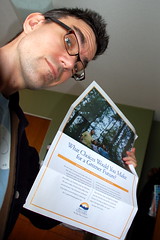 British Columbia's Liberal provincial government (not renowned for its environmental record) recently sent out a tabloid-sized, four-page flyer to B.C. residents. We received ours today. The title is "What Choices Would You Make for a Greener Future?: Budget 2008 Consultation Paper" (here's the PDF).
British Columbia's Liberal provincial government (not renowned for its environmental record) recently sent out a tabloid-sized, four-page flyer to B.C. residents. We received ours today. The title is "What Choices Would You Make for a Greener Future?: Budget 2008 Consultation Paper" (here's the PDF).
In essence, it asks us where we think the government should spend money to reduce greenhouse gas emissions, encourage alternative power sources and transportation options, pay for healthcare costs, and provide adequate housing for our fellow citizens.
There is an online version of the questionnaire, which is handy. Overall, it's an interesting and encouraging idea. But before even reading the flyer, I flipped it over and read the fine print:
Normally I would think it wise—indeed expected—for governments to use paper with a reasonable proportion of recycled pulp in it, and 40% isn't bad. But for a flyer talking about a "greener future," using 100% post-consumer recycled paper is the only reasonable choice. I wouldn't care if it was brown or grey rather than stark white.
As it is, the 40% recycled content (or rather, the 60% non-recycled content) makes the whole publication and the process behind it look like lip service to environmental causes. Gillian also notes that there's a whole stack of the flyers in her building's recycling bin next to the mailboxes—a stack that certainly never got read.
While I'm filling out the online questionnaire, I will be wondering where my opinions will be registered, and whether they'll end up 60% watered down as well. It's too bad I ended up thinking so cynically.
Labels: environment, government, green, science
Wacka wacka!
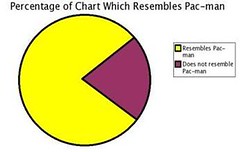 Your friend and mine, Pac-Man turns 28 years old today.
Your friend and mine, Pac-Man turns 28 years old today.
I never had a full-fledged case of Pac-Man Fever, but I did spend a good amount of time playing clones like Gobbler, Snack Attack, and Taxman on my Apple II. Plus I had the September 1982 Mad magazine with Pac-Man on the cover.
The Nintendo version is now available as a cheap download or disc for our Wii, or even for my iPod—maybe I should give it a spin for nostalgia's sake.
Labels: anniversary, apple, birthday, games, geekery, history, nintendo
09 October 2007
How a portacath works
A few people have asked me how the portacath (or more simply, "port") that I had surgically implanted last Thursday actually works. I wondered that myself until the nurse explained it before wheeling me into the operating room.
You can see from the photo at Wikipedia that the device comprises a small, round, dome-shaped reservoir—about the diameter of a Canadian dollar coin—and a tube about 30 cm long attached to it:
Dr. Chen, my vascular surgeon, put the reservoir just under my skin on the upper right portion of my chest, under my clavicle, then threaded the tube up into my jugular vein and down again so that the outlet is near my heart.
 All of that is subcutaneous, so that the reservoir is a big bump under my skin and the tube is just visible in my neck, as you can see in my portacath self-portrait. (Beware, you have to look at my shirtless, half-shaved, still scarred and bruised chest.) Right now it's all still a bit itchy as the scars heal and the stitches dissolve, but it should be pretty comfortable in a few days.
All of that is subcutaneous, so that the reservoir is a big bump under my skin and the tube is just visible in my neck, as you can see in my portacath self-portrait. (Beware, you have to look at my shirtless, half-shaved, still scarred and bruised chest.) Right now it's all still a bit itchy as the scars heal and the stitches dissolve, but it should be pretty comfortable in a few days.
Now, what will happen next Monday when I start chemotherapy again is that a nurse at the B.C. Cancer Agency will put a needle through my skin into the centre of the reservoir's plastic dome, and the chemo drugs will feed through there. After sitting for a few hours getting my first infusion at the Agency, I will be sent home with a small bottle also attached to the same needle, which I will keep on for two solid days until a health nurse comes to remove the bottle and needle and flush out the portacath with saline solution and heparin to keep it from getting clogged.
For the following 12 days or so, I just have the bump under my skin again. Then I go back to the Cancer Agency and start the process over. Lather, rinse, repeat for three to six months. Rather than having to start a fresh intravenous drip every time, the nurses can simply plug into the portacath, which saves pain, awkwardness, and effort, and lets me take the 48-hour infusion home with me instead of having to stay at the clinic, which is a bonus.
Assuming the chemo treatment works, once it is done some months down the line, a doctor can remove the portacath again and I will heal up with just some minor scars.
Any questions?
Labels: cancer, chemotherapy, surgery
08 October 2007
Get kraken
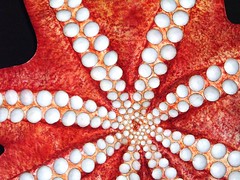 For my degree in Marine Biology (UBC 1990), I specialized in marine invertebrates, and wrote one pretty good paper on giant squid. Most of my studies actually involved echinoderms and cnidarians, but today I'll indulge in my soft spot for squids, octopuses, cuttlefish, and others honoured on International Cephalopod Awareness Day.
For my degree in Marine Biology (UBC 1990), I specialized in marine invertebrates, and wrote one pretty good paper on giant squid. Most of my studies actually involved echinoderms and cnidarians, but today I'll indulge in my soft spot for squids, octopuses, cuttlefish, and others honoured on International Cephalopod Awareness Day.
Oh, and it's also Canadian Thanksgiving: we're having a big family party tonight. No cephalopods will be served. We're just doing the usual turkey thing.
However, let's be thankful for the cephalopods. Like us, they are big-brained, smart, agile, and dextrous. In so many other ways, though, they are so unlike us that if they didn't exist, we might not be able to imagine them.
UPDATE: PZ Myers posts lots of links about the day at his blog.
Labels: family, food, holiday, invertebrates, marine, science
07 October 2007
Good deals at SmartCanucks.ca
Speaking of my wife, she found SmartCanucks.ca, "The First Canadian Deals Blog." Some good deals there so far.
Labels: family, geekery, shopping, web
Bandages and partners
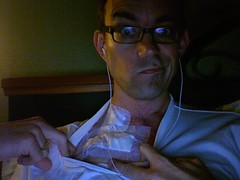 On Thursday, I spent a few hours at Vancouver Hospital in order to have a portacath inserted. It was a relatively minor surgical procedure, involving only some local anaesthetic and a bit of tranquilizer. Dr. Chen the vascular surgeon (coincidentally, the same guy who was supposed to treat my varicose veins in February, before my cancer diagnosis derailed things) put the port under my skin so that when I start chemotherapy in a couple of weeks, the nurses won't have to start a fresh IV every time I go to the cancer clinic.
On Thursday, I spent a few hours at Vancouver Hospital in order to have a portacath inserted. It was a relatively minor surgical procedure, involving only some local anaesthetic and a bit of tranquilizer. Dr. Chen the vascular surgeon (coincidentally, the same guy who was supposed to treat my varicose veins in February, before my cancer diagnosis derailed things) put the port under my skin so that when I start chemotherapy in a couple of weeks, the nurses won't have to start a fresh IV every time I go to the cancer clinic.
Now I have a couple of big nasty bandages and the red stain from surgical disinfectant on the shaved right portion of my chest for a few days—I'm not allowed to shower or get the area wet until it's healed up. Compared to the major surgery and other things I've gone through in the past few months, this procedure was barely a blip.
Of course, as always, my lovely wife picked me up at the hospital. She has been amazing this year, shuttling me around and keeping the house running and the kids clean and clothed and fed and loved, as well as working and podcasting and helping out her friends too, while I've bounced from cranky chemoradiation victim to emaciated hospital patient to cane-toting recovery guy (with chemo coming again soon). And she still loves me, even as my treatments turn me into a half-mechanical cyborg.
She's the biggest reason I want to fight this disease and win. When we got married twelve years ago, I planned to grow old with her, and that's still what I so desperately want to do. Our kids, my parents and relatives, my friends and colleagues—they are all important too. But my wife, my partner, is the person I love and need the most.
I may not show that or say it as much as she deserves, but having her here with me is keeping me alive as much as any of the drugs or surgeries or blasts of charged particles. She's The One, and always will be.
Labels: cancer, chemotherapy, family, love, surgery
06 October 2007
Religion and fundamentalism
This is an excellent written debate between American pundits Andrew Sullivan (iconoclastic gay right-winger and moderate Christian) and Sam Harris (well-known atheism activist and proponent of meditation) on the nature of religion and fundamentalism. It happened last spring, but I only just stumbled on it.
They continue to disagree at the end, but manage to spar more politely and interestingly than the usual shouting matches on the subject.
Labels: andrewsullivan, creationism, debate, evolution, religion, samharris
05 October 2007
Tim Bray: people are the killer app
I was pleased and honoured to have Lauren Wood and Tim Bray and their kids come to my birthday party back in June. One of the reasons it was an honour is that Tim is both a pioneering Internet tech-head and a socially thoughtful guy. His latest post is a gem:
TechCrunch? The top story when I last checked was "Pixsy To Power Search On Veoh". I’m containing my excitement.
It seems there's an inward-facing circle scattered around San Francisco and its peninsula; they're smart and experienced and money-hungry and very alert. But when the next big thing comes along (and I love this business, because I know it will) you won't have to rely on the professional noticers to tell you because it'll touch your life directly.
It's good that Tim and Lauren chose to live here in Vancouver rather than the Bay Area: they get more perspective, I think.
Labels: birthday, geekery, timbray, vancouver, web
Put your guitar stack into your computer
Several months ago my podcast co-host and I recorded a segment on guitar effects for The Lab With Leo TV show. The episode is finally available online through Google video:
We recorded another couple of bits with Leo this week, so it may be awhile before you can see those online as well, but they'll come eventually.
Labels: insidehomerecording, labwithleo, leolaporte, podcast, television
04 October 2007
Happy birthday, Sputnik
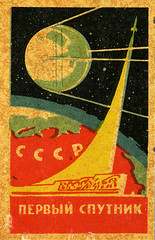 Back in the late 1970s, a traveling exhibition of Soviet space program artifacts and replicas came to the H.R. MacMillan Planetarium here in Vancouver. My parents had bought a lifetime membership to the Planetarium when it opened in the late '60s, so we went there all the time, and this was a particularly exciting event.
Back in the late 1970s, a traveling exhibition of Soviet space program artifacts and replicas came to the H.R. MacMillan Planetarium here in Vancouver. My parents had bought a lifetime membership to the Planetarium when it opened in the late '60s, so we went there all the time, and this was a particularly exciting event.
The part that made the biggest impression on me was the very loud demonstration scale model of the massive Soyuz rocket that launched (and still launches) Russian space capsules. I remember its distinctly Russian shape, with the flared boosters at the bottom, so different from the straight-arrow American designs such as the Saturn moon rockets.
When I saw the exhibition, Sputnik was not even a quarter century in the past, but to me as a kid it was ancient history. In that time, people had orbited the Earth, gone to the Moon, sent robots throughout the solar system, and were about to launch the first reusable Space Shuttle.
Today is the 50th anniversary of that first-ever Sputnik orbital flight. As far as people going into space, not much genuinely new has happened since I saw those Soviet rockets. We have the space station now (built through cooperation between post-Soviet Russia, NASA, and other space programs around the world), but we're also still flying Soyuz and Shuttle missions, and no one has been back to the Moon since 1972.
Sputnik was the first, and it turns out to have been the model too. Its successors, robotic space probes, have accomplished remarkable things since, from examining the Sun to plunging into the atmosphere of Jupiter, landing on Saturn's moon Titan, and going way beyond. Every day, people across the globe use communications satellites and GPS and satellite views on Google Maps without a second thought. Sputnik, by striking fear of Communist supremacy into our hearts, also energized the Western world's science education programs. Indirectly, I'm probably alive today because of the scientific and medical research prompted by those changes, which improved treatments for both diabetes and cancer.
That tiny beeping metal sphere really did change the world. S dniom razhdjenia, Sputnik.
UPDATE: IEEE Spectrum has a nice feature on the anniversary, including an interview with Arthur C. Clarke in which he points out that "space travel is a technological mutation that should not really have arrived until the 21st century. But thanks to the ambition and genius of [Wernher] von Braun and Sergei Korolev, and their influence upon individuals as disparate as Kennedy and Khrushchev, the Moon—like the South Pole—was reached half a century ahead of time."
Labels: anniversary, astronomy, birthday, science, space
03 October 2007
Recording more "Lab With Leo" today
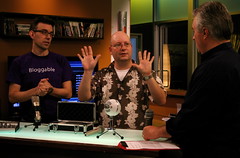 Back in June, my podcast co-host Paul Garay and I recorded a couple of segments for Leo Laporte's cable tech television show The Lab With Leo. The episodes went on air a few weeks later.
Back in June, my podcast co-host Paul Garay and I recorded a couple of segments for Leo Laporte's cable tech television show The Lab With Leo. The episodes went on air a few weeks later.
Today Paul and I are recording two more bits, about Apple's Logic Studio 8 and hybrid multi-function audio devices. The episodes we make today will go on air at G4 Tech TV in Canada and the How To Channel in Australia later this year.
Appearing on The Lab is fun, and I can say that Leo—a long-time radio and TV host, as well as a podcasting pioneer—is pretty much exactly the same nice guy in person as he is on air and on podcasts.
Labels: insidehomerecording, labwithleo, leolaporte, podcast, television
01 October 2007
The Blue Fox pushes me over the line at last
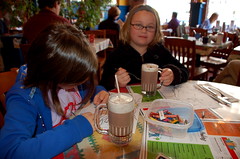 This morning, for our last major meal in Victoria, my daughters and I let my wife sleep in and met my friend Simon for breakfast at a place he recommended, the Blue Fox Café on Fort Street.
This morning, for our last major meal in Victoria, my daughters and I let my wife sleep in and met my friend Simon for breakfast at a place he recommended, the Blue Fox Café on Fort Street.
I've walked by the Blue Fox a few times before, noting how busy it was, usually with a lineup. Fortunately, since today is Monday, we found no line at 9 a.m., although the place was still busy. I can see why it's popular: tasty and wholesome versions of basic breakfast foods (eggs, French toast, roast potatoes, sausage and bacon, coffee) in large portions, with reasonable prices and friendly service, plus vaguely ethnic Mediterranean-Mexican-Southwest decor (lots of saffron yellows and deep blues) and reggae music on the sound system. We all ate a lot, and my daughters had two hot chocolates each ("Best ever!" said my oldest). Ah, vacation.
Anyway, it seems that meal finally helped me reach a milestone. When I weighed myself at home tonight, I hit 176 pounds, the first time I've been over 175 since before my cancer surgery way back in July, some 30 pounds above what I weighed at my worst in hospital late in that month, and only about 15 pounds below what I probably should weigh, which is about 190. (I hovered around 200 pounds for many years until my cancer diagnosis early in 2007.)
I'm still a bit too thin and bony, but, other than the damned ileostomy bag, I feel more like a normal human being than I have for a long time. And I take considerable pleasure in being able to pig out pretty much as I like, within the confines of my diabetic diet. I hope I can keep that up once the next round of chemotherapy starts in a couple of weeks.
I'll be back to the Blue Fox on our next visit to Victoria, that's for sure. The kids want mom to come with us.
Labels: cancer, diabetes, food, travel, victoria





